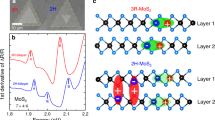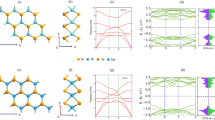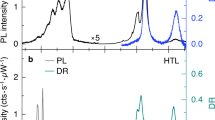Abstract
Two-dimensional materials offer an exciting platform that enables the creation of van der Waals heterostructures with rich functions and intriguing physical properties that stem from different band alignments and diverse interlayer interactions. However, further exploration of two-dimensional van der Waals heterostructures is hindered by the limited coupling strength and lack of efficient methods for tuning the interlayer interactions. Here, by using a two-step chemical vapour deposition method, we realize high-quality 2H-stacked WSe2–MoSe2 heterostructures with strong interlayer coupling, and effective tuning of their interlayer interaction by hydrostatic pressure. We unambiguously establish the strong coupling nature in these WSe2–MoSe2 heterostructures through the existence of exclusive interlayer excitons instead of the typical intralayer excitons. We further demonstrate efficient tuning of the interlayer coupling by using pressure engineering, and observe a clear evolution and transition of interlayer excitons in WSe2–MoSe2 heterostructures with a pressure-induced band changeover, which is further confirmed by first-principles calculations. Our findings provide new opportunities for producing, exploring and tuning van der Waals heterostructures with strong interlayer coupling that can lead towards the realization of future excitonic devices based on tailor-made, atomically thin, two-dimensional stacks.
This is a preview of subscription content, access via your institution
Access options
Access Nature and 54 other Nature Portfolio journals
Get Nature+, our best-value online-access subscription
$29.99 / 30 days
cancel any time
Subscribe to this journal
Receive 12 print issues and online access
$209.00 per year
only $17.42 per issue
Buy this article
- Purchase on Springer Link
- Instant access to full article PDF
Prices may be subject to local taxes which are calculated during checkout




Similar content being viewed by others
Data availability
Source data are provided with this paper. All other data that support the plots within this paper and other findings of this study are available from the corresponding authors upon reasonable request.
References
Novoselov, K. S., Mishchenko, A., Carvalho, A. & Castro Neto, A. H. 2D materials and van der Waals heterostructures. Science 353, aac9439 (2016).
Koda, D. S., Bechstedt, F., Marques, M. & Teles, L. K. Tuning electronic properties and band alignments of phosphorene combined with MoSe2 and WSe2. J. Phys. Chem. C 121, 3862–3869 (2017).
Hunt, B. et al. Massive Dirac fermions and Hofstadter butterfly in a van der Waals heterostructure. Science 340, 1427–1430 (2013).
Li, X. et al. Two-dimensional GaSe/MoSe2 misfit bilayer heterojunctions by van der Waals epitaxy. Sci. Adv. 2, e1501882 (2016).
Rivera, P. et al. Valley-polarized exciton dynamics in a 2D semiconductor heterostructure. Science 351, 688–691 (2016).
Zhang, W., Wang, Q., Chen, Y., Wang, Z. & Wee, A. T. S. Van der Waals stacked 2D layered materials for optoelectronics. 2D Mater. 3, 022001 (2016).
Gong, Y. et al. Vertical and in-plane heterostructures from WS2/MoS2 monolayers. Nat. Mater. 13, 1135–1142 (2014).
Peng, B. et al. Ultrafast charge transfer in MoS2/WSe2 p–n heterojunction. 2D Mater. 3, 025020 (2016).
Latini, S., Winther, K. T., Olsen, T. & Thygesen, K. S. Interlayer excitons and band alignment in MoS2/hBN/WSe2 van der Waals heterostructures. Nano Lett. 17, 938–945 (2017).
Rivera, P. et al. Observation of long-lived interlayer excitons in monolayer MoSe2–WSe2 heterostructures. Nat. Commun. 6, 6242 (2015).
Choudhary, N. et al. Centimeter scale patterned growth of vertically stacked few layer only 2D MoS2/WS2 van der Waals heterostructure. Sci. Rep. 6, 25456 (2016).
Wang, F. et al. Tuning coupling behavior of stacked heterostructures based on MoS2, WS2, and WSe2. Sci. Rep. 7, 44712 (2017).
Puretzky, A. A. et al. Low-frequency Raman fingerprints of two-dimensional metal dichalcogenide layer stacking configurations. ACS Nano 9, 6333–6342 (2015).
Xia, J., Yan, J. & Shen, Z. X. Transition metal dichalcogenides: structural, optical and electronic property tuning via thickness and stacking. FlatChem 4, 1–19 (2017).
Zhao, Y. et al. Interlayer breathing and shear modes in few-trilayer MoS2 and WSe2. Nano Lett. 13, 1007–1015 (2013).
Nayak, P. K. et al. Probing evolution of twist-angle-dependent interlayer excitons in MoSe2/WSe2 van der Waals heterostructures. ACS Nano 11, 4041–4050 (2017).
Yan, J. et al. Stacking-dependent interlayer coupling in trilayer MoS2 with broken inversion symmetry. Nano Lett. 15, 8155–8161 (2015).
Son, Y. et al. Observation of switchable photoresponse of a monolayer WSe2–MoS2 lateral heterostructure via photocurrent spectral atomic force microscopic imaging. Nano Lett. 16, 3571–3577 2016).
Mitioglu, A. A. et al. Optical investigation of monolayer and bulk tungsten diselenide (WSe2) in high magnetic fields. Nano Lett. 15, 4387–4392 (2015).
He, Y. et al. Strain-induced electronic structure changes in stacked van der Waals heterostructures. Nano Lett. 16, 3314–3320 (2016).
Chen, M. et al. Ordered and atomically perfect fragmentation of layered transition metal dichalcogenides via mechanical instabilities. ACS Nano 11, 9191–9199 (2017).
Tongay, S. et al. Tuning interlayer coupling in large-area heterostructures with CVD-grown MoS2 and WS2 monolayers. Nano Lett. 14, 3185–3190 (2014).
Fan, W. et al. Vibrational spectrum renormalization by enforced coupling across the van der Waals gap between MoS2 and WS2 monolayers. Phys. Rev. B 92, 241408 (2015).
Rooney, A. P. et al. Observing imperfection in atomic interfaces for van der Waals heterostructures. Nano Lett. 17, 5222–5228 (2017).
Pizzocchero, F. et al. The hot pick-up technique for batch assembly of van der Waals heterostructures. Nat. Commun. 7, 11894 (2016).
Yu, H., Liu, G.-B., Tang, J., Xu, X. & Yao, W. Moiré excitons: from programmable quantum emitter arrays to spin-orbit–coupled artificial lattices. Sci. Adv. 3, e1701696 (2017).
Zhang, N. et al. Moiré Intralayer Excitons in a MoSe2/MoS2 Heterostructure. Nano Lett. 18, 7651–7657 (2018).
Seyler, K. L. et al. Signatures of moiré-trapped valley excitons in MoSe2/WSe2 heterobilayers. Nature 567, 66–70 (2019).
Tran, K. et al. Evidence for moiré excitons in van der Waals heterostructures. Nature 567, 71–75 (2019).
Alexeev, E. M. et al. Resonantly hybridized excitons in moiré superlattices in van der Waals heterostructures. Nature 567, 81–86 (2019).
Jin, C. et al. Observation of moiré excitons in WSe2/WS2 heterostructure superlattices. Nature 567, 76–80 (2019).
Conley, H. J. et al. Bandgap engineering of strained monolayer and bilayer MoS2. Nano Lett. 13, 3626–3630 (2013).
Hui, Y. Y. et al. Exceptional tunability of band energy in a compressively strained trilayer MoS2 sheet. ACS Nano 7, 7126–7131 (2013).
Yankowitz, M. et al. Dynamic band-structure tuning of graphene moiré superlattices with pressure. Nature 557, 404–408 (2018).
Yu, Y. et al. Equally efficient interlayer exciton relaxation and improved absorption in epitaxial and nonepitaxial MoS2/WS2 heterostructures. Nano Lett. 15, 486–491 (2015).
Gong, Y. et al. Two-step growth of two-dimensional WSe2/MoSe2 heterostructures. Nano Lett. 15, 6135–6141 (2015).
Puretzky, A. A. et al. Twisted MoSe2 bilayers with variable local stacking and interlayer coupling revealed by low-frequency Raman spectroscopy. ACS Nano 10, 2736–2744 (2016).
O’Brien, M. et al. Mapping of low-frequency Raman modes in CVD-grown transition metal dichalcogenides: layer number, stacking orientation and resonant effects. Sci. Rep. 6, 19476 (2016).
Xia, J. et al. Current rectification and asymmetric photoresponse in MoS2 stacking-induced homojunctions. 2D Mater. 4, 035011 (2017).
Xia, J. et al. Valley polarization in stacked MoS2 induced by circularly polarized light. Nano Res. 10, 1618–1626 (2017).
Heo, H. et al. Interlayer orientation-dependent light absorption and emission in monolayer semiconductor stacks. Nat. Commun. 6, 7372 (2015).
Wang, L. et al. Slow cooling and efficient extraction of C-exciton hot carriers in MoS2 monolayer. Nat. Commun. 8, 13906 (2017).
Zhao, Z. et al. Pressure induced metallization with absence of structural transition in layered molybdenum diselenide. Nat. Commun. 6, 7312 (2015).
Wang, X. et al. Pressure-induced iso-structural phase transition and metallization in WSe2. Sci. Rep. 7, 46694 (2017).
Xia, J. et al. Pressure-induced phase transition in Weyl semimetallic WTe2. Small 13, 1701887 (2017).
Ruf, F. et al. Temperature-dependent studies of exciton binding energy and phase-transition suppression in (Cs,FA,MA)Pb(I,Br)3 perovskites. APL Mater. 7, 031113 (2019).
Elliot, R. J. Intensity of optical absorption by excitons. Phys. Rev. 108, 1384–1389 (1957).
Saba, M. et al. Correlated electron–hole plasma in organometal perovskites. Nat. Commun. 5, 5049 (2014).
Chaves, A. J., Ribeiro, R. M., Frederico, T. & Peres, N. M. R. Excitonic effects in the optical properties of 2D materials: an equation of motion approach. 2D Mater. 4, 025086 (2017).
Dou, X., Ding, K., Jiang, D. & Sun, B. Tuning and identification of interband transitions in monolayer and bilayer molybdenum disulfide using hydrostatic pressure. ACS Nano 8, 7458–7464 (2014).
Giannozzi, P. et al. Advanced capabilities for materials modelling with Quantum ESPRESSO. J. Phys. Condens. Matter 29, 465901 (2017).
Hamann, D. R. Optimized norm-conserving Vanderbilt pseudopotentials. Phys. Rev. B 88, 085117 (2013).
Dion, M., Rydberg, H., Schröder, E., Langreth, D. C. & Lundqvist, B. I. Van der Waals density functional for general geometries. Phys. Rev. Lett. 92, 246401 (2004).
Blöchl, P. E. Projector augmented-wave method. Phys. Rev. B 50, 17953–17979 (1994).
Kresse, G. & Furthmüller, J. Efficient iterative schemes for ab initio total-energy calculations using a plane-wave basis set. Phys. Rev. B 54, 11169–11186 (1996).
Klimeš, J., Bowler, D. R. & Michaelides, A. Van der Waals density functionals applied to solids. Phys. Rev. B 83, 195131 (2011).
Lazzeri, M. & Mauri, F. First-principles calculation of vibrational Raman spectra in large systems: signature of small rings in crystalline SiO2. Phys. Rev. Lett. 90, 036401 (2003).
Acknowledgements
J.X. and Z.W. acknowledge support from the Ministry of Science and Technology of China (grant no. 2018YFE0115500), the National Natural Science Foundation of China (no. 61774029) and the Science and Technology Department of Sichuan Province in China (nos. 2019JDTD0006 and 2019YFSY0007). J.Y. gratefully acknowledges financial support from the National Natural Science Foundation of China (grant no. 11704185) and the Natural Science Foundation of Jiangsu Province in China (no. BK20171021). Z.S. gratefully acknowledges the Ministry of Education of Singapore for the funding of this research through AcRF Tier 1 grants (nos. RG103/16 and RG195/17) and a Tier 3 grant (no. MOE2016-T3-1-006 (S)). Z.L. acknowledges funding support through a Tier 3 grant (no. MOE2018-T3-1-002), a Tier 2 grant (no. MOE2016-T2-2-153) and the A*STAR Quantum Technologies for Engineering Programme. J.X. and Z.W. thank S. Shi for helpful discussions, and the support from our group members T. Wen, Y. Liang, B. Xu, F. Xiao, J. Zhu, J. Fang, S. Wu, J. Li, Q. Deng, F. Wang and Z. Zhang.
Author information
Authors and Affiliations
Contributions
J.X., J.Y. and Z.S. conceived the study. J.X. performed the experimental work. J.Y. performed the simulation studies. J.X., Z.W. and J.Y. analysed the data. Y.H. and Z.L. helped to prepare the heterostructure samples. Y.G. and P.M.A. performed the TEM/STEM measurements. W.C. and T.C.S. helped with the ultrafast pump–probe measurements. J.X. and Z.W. wrote and revised the manuscript. All authors discussed the results.
Corresponding authors
Ethics declarations
Competing interests
The authors declare no competing interests.
Additional information
Peer review information Nature Physics thanks Fred Withers and the other, anonymous, reviewer(s) for their contribution to the peer review of this work.
Publisher’s note Springer Nature remains neutral with regard to jurisdictional claims in published maps and institutional affiliations.
Supplementary information
Supplementary Information
Supplementary Figs. 1–15 and Supplementary Tables 1 and 2.
Source data
Source Data Fig. 2
Data in Cartesian plots.
Source Data Fig. 3
Data in Cartesian plots.
Source Data Fig. 4
Data in Cartesian plots.
Rights and permissions
About this article
Cite this article
Xia, J., Yan, J., Wang, Z. et al. Strong coupling and pressure engineering in WSe2–MoSe2 heterobilayers. Nat. Phys. 17, 92–98 (2021). https://doi.org/10.1038/s41567-020-1005-7
Received:
Accepted:
Published:
Issue Date:
DOI: https://doi.org/10.1038/s41567-020-1005-7
This article is cited by
-
Excitonic devices based on two-dimensional transition metal dichalcogenides van der Waals heterostructures
Frontiers of Chemical Science and Engineering (2024)
-
Manipulating exchange bias in 2D magnetic heterojunction for high-performance robust memory applications
Nature Communications (2023)
-
Temperature-pressure phase diagram of confined monolayer water/ice at first-principles accuracy with a machine-learning force field
Nature Communications (2023)
-
Tunable interlayer excitons and switchable interlayer trions via dynamic near-field cavity
Light: Science & Applications (2023)
-
Electrically tunable two-dimensional heterojunctions for miniaturized near-infrared spectrometers
Nature Communications (2022)



